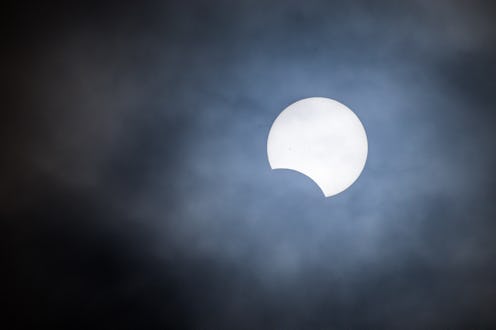Life
How To Safely Watch A Solar Eclipse

You know you're not supposed to stare directly into the sun, and yet, on most sunny days, you probably just can't help it. We definitely have an innate thirst for whatever we're told not to do — whether it's touching the stove, or testing dry paint, or picking at scabs. But when it comes to big celestial events like eclipses, toying with the suggestion of authorities can be really dangerous. Knowing how to safely watch a solar eclipse is an important cautionary concept to consider.
There are three different kinds of solar eclipses, with danger levels that very depending on the type of eclipse. Some eclipses are so dangerous they can cause blindness and injury to the eye. So yeah, if you mom made you wear special solar block glasses to watch the eclipse when you were a kid, she wasn't being overprotective — the strength of the sun really is that powerful.
The first kind of solar eclipse is called a partial eclipse. This is when the moon comes between the Earth and the sun, but doesn't perfectly align, so it only covers some of the sun's disk. This gives it a bitten or crescent shape. This kind of solar eclipse, though partially blocked, is completely unsafe to watch without proper eye protection. NASA recommends protection that meets the ISO 12312-2 standard. Similarly, the annular solar eclipse is not safe to watch without protection. This eclipse creates a ring of fire shape and even though the amount of sunlight that's available during this eclipse is so thin, it's still considered dangerous. Brands that NASA trusts to make reliable protective eyewear suitable to watching these types of solar eclipses are: Rainbow Symphony, American Paper Optics and Thousand Oaks Optical.
The other type of solar eclipse is the total eclipse, and that's the only kind that's safely viewable with the naked eye. Why? Because the moon completely blocks the Earth's view of the sun's disk, so none of the harmful rays can make their way to our eyes. For this reason, this type of eclipse is probably the most fun to see. Astronomers love this eclipse because it gives viewers a chance to notice things about the sun that we would otherwise not see. Because the sun is so bright, on an average day, we cannot see its atmosphere. But when the direct light source is blocked out, we get to see these dreamy, wave-like signs of its atmosphere. And if you wore glasses, you wouldn't be able to see these details. So an eclipse that's safe enough to view with the naked eye is the best kind of eclipse to observe, according to astronomers.
If this information has served as exciting news for you, you're in luck. Monday, Aug. 21, 2017 is going to be a total solar eclipse. This is the first total solar eclipse since 1979, so mark your calendar. Though it will be hard to miss for us in the United States, you're going to want to be totally prepared for viewing, so you don't miss a thing!